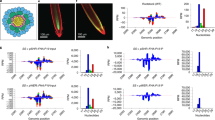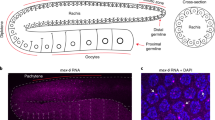Abstract
Organism-wide RNA interference (RNAi) is due to the transport of mobile silencing RNA throughout the organism, but the identities of these mobile RNA species in animals are unknown. Here, we present genetic evidence that both the initial double-stranded RNA (dsRNA), which triggers RNAi, and at least one dsRNA intermediate produced during RNAi can act as or generate mobile silencing RNA in C. elegans. This dsRNA intermediate requires the long dsRNA-binding protein RDE-4, the endonuclease DCR-1, which cleaves long dsRNA into double-stranded short-interfering RNA (ds-siRNA), and the putative nucleotidyltransferase MUT-2 (RDE-3). However, single-stranded siRNA and downstream secondary siRNA produced upon amplification by the RNA-dependent RNA polymerase RRF-1 do not generate mobile silencing RNA. Restricting intertissue transport to long dsRNA and directly processed siRNA intermediates rather than amplified siRNA may serve to modulate the extent of systemic silencing in proportion to available dsRNA.
This is a preview of subscription content, access via your institution
Access options
Subscribe to this journal
Receive 12 print issues and online access
$189.00 per year
only $15.75 per issue
Buy this article
- Purchase on Springer Link
- Instant access to full article PDF
Prices may be subject to local taxes which are calculated during checkout




Similar content being viewed by others
References
Jose, A.M. & Hunter, C.P. Transport of sequence-specific RNA interference information between cells. Annu. Rev. Genet. 41, 305–330 (2007).
Molnar, A. et al. Small silencing RNAs in plants are mobile and direct epigenetic modification in recipient cells. Science 328, 872–875 (2010).
Dunoyer, P. et al. Small RNA duplexes function as mobile silencing signals between plant cells. Science 328, 912–916 (2010).
Dunoyer, P. et al. An endogenous, systemic RNAi pathway in plants. EMBO J. 29, 1699–1712 (2010).
Winston, W.M., Molodowitch, C. & Hunter, C.P. Systemic RNAi in C. elegans requires the putative transmembrane protein SID-1. Science 295, 2456–2459 (2002).
Feinberg, E.H. & Hunter, C.P. Transport of dsRNA into cells by the transmembrane protein SID-1. Science 301, 1545–1547 (2003).
Wolfrum, C. et al. Mechanisms and optimization of in vivo delivery of lipophlic siRNAs. Nat. Biotechnol. 25, 1149–1157 (2007).
Jose, A.M., Smith, J.J. & Hunter, C.P. Export of RNA silencing from C. elegans tissues does not require the RNA channel SID-1. Proc. Natl. Acad. Sci. USA 106, 2283–2288 (2009).
Faghihi, M.A. & Wahlestedt, C. Regulatory roles of natural antisense transcripts. Nat. Rev. Mol. Cell Biol. 10, 637–643 (2009).
Fire, A. et al. Potent and specific genetic interference by double-stranded RNA in Caenorhabditis elegans. Nature 391, 806–811 (1998).
Grishok, A. RNAi mechanisms in Caenorhabditis elegans. FEBS Lett. 579, 5932–5939 (2005).
Aoki, K., Moriguchi, H., Yoshioka, T., Okawa, K. & Tabara, H. In vitro analyses of the production and activity of secondary small interfering RNAs in C. elegans. EMBO J. 26, 5007–5019 (2007).
Steiner, F.A., Okihara, K.L., Hoogstrate, S.W., Sijen, T. & Ketting, R.F. RDE-1 slicer activity is required only for passenger-strand cleavage during RNAi in Caenorhabditis elegans. Nat. Struct. Mol. Biol. 16, 207–211 (2009).
Chen, C.C. et al. A member of the polymerase beta nucleotidyltransferase superfamily is required for RNA interference in C. elegans. Curr. Biol. 15, 378–383 (2005).
Moazed, D. et al. Studies on the mechanism of RNAi-dependent heterochromatin assembly. Cold Spring Harb. Symp. Quant. Biol. 71, 461–471 (2006).
van Wolfswinkel, J.C. et al. CDE-1 affects chromosome segregation through uridylation of CSR-1-bound siRNAs. Cell 139, 135–148 (2009).
Tabara, H. et al. The rde-1 gene, RNA interference, and transposon silencing in C. elegans. Cell 99, 123–132 (1999).
Grishok, A., Tabara, H. & Mello, C.C. Genetic requirements for inheritance of RNAi in C. elegans. Science 287, 2494–2497 (2000).
Parker, G.S., Eckert, D.M. & Bass, B.L. RDE-4 preferentially binds long dsRNA and its dimerization is necessary for cleavage of dsRNA to siRNA. RNA 12, 807–818 (2006).
Habig, J.W., Aruscavage, P.J. & Bass, B.L. In C. elegans, high levels of dsRNA allow RNAi in the absence of RDE-4. PLoS ONE 3, e4052 (2008).
Timmons, L. & Fire, A. Specific interference by ingested dsRNA. Nature 395, 854 (1998).
Qadota, H. et al. Establishment of a tissue-specific RNAi system in C. elegans. Gene 400, 166–173 (2007).
Kwak, J.E. & Wickens, M. A family of poly(U) polymerases. RNA 13, 860–867 (2007).
Ren, H. & Zhang, H. Wnt signaling controls temporal identities of seam cells in Caenorhabditis elegans. Dev. Biol. 345, 144–155 (2010).
Kennedy, S., Wang, D. & Ruvkun, G. A conserved siRNA-degrading RNase negatively regulates RNA interference in C. elegans. Nature 427, 645–649 (2004).
Hyun, T.K., Uddin, M.N., Rim, Y. & Kim, J.Y. Cell-to-cell trafficking of RNA and RNA silencing through plasmodesmata. Protoplasma 248, 101–116 (2011).
Shih, J.D. & Hunter, C.P. SID-1 is a ds-RNA selective ds-RNA gated channel. RNA 17, 1057–1065 (2011).
Elbashir, S.M. et al. Duplexes of 21-nucleotide RNAs mediate RNA interference in cultured mammalian cells. Nature 411, 494–498 (2001).
Kok, K.H., Ng, M.-H.J., Ching, Y.-P. & Jin, D.-Y. Human TRBP and PACT directly interact with each other and associate with Dicer to facilitate the production of small interfering RNA. J. Biol. Chem. 282, 17649–17657 (2007).
Timmons, L., Tabara, H., Mello, C.C. & Fire, A.Z. Inducible systemic RNA silencing in Caenorhabditis elegans. Mol. Biol. Cell 14, 2972–2983 (2003).
Tournier, B., Tabler, M. & Kalantidis, K. Phloem flow strongly influences the systemic spread of silencing in GFP Nicotiana benthamiana plants. Plant J. 47, 383–394 (2006).
Calixto, A., Chelur, D., Topalidou, I., Chen, X. & Chalfie, M. Enhanced neuronal RNAi in C. elegans using SID-1. Nat. Methods 7, 554–559 (2010).
Hobert, O. PCR fusion-based approach to create reporter gene constructs for expression analysis in transgenic C. elegans. Biotechniques 32, 728–730 (2002).
Mello, C.C., Kramer, J.M., Stinchcomb, D. & Ambros, V. Efficient gene transfer in C. elegans: extrachromosomal maintenance and integration of transforming sequences. EMBO J. 10, 3959–3970 (1991).
Newcombe, R.G. Two-sided confidence intervals for the single proportion: comparison of seven methods. Stat. Med. 17, 857–872 (1998).
Acknowledgements
We thank K. Ragkousi, S. Mango and members of the Hunter lab, particularly K. Pang, J. Brooks and D. Schott for comments on the manuscript; the C. elegans Genetics Center for some strains; H. Zhang, National Institute of Biological Sciences, for HZ202; S. Ekman (Harvard University) for two constructs; and the US National Institutes of Health (grant K99-GM085200 to A.M.J. and GM089795 to C.P.H.) and the National Science Foundation (MCB-0744029 to C.P.H.) for funding.
Author information
Authors and Affiliations
Contributions
A.M.J. conducted the experiments and G.A.G. generated most of the DNA constructs; A.M.J. and C.P.H. designed the study, analyzed the data and wrote the paper. All authors discussed the results and commented on the manuscript.
Corresponding author
Ethics declarations
Competing interests
The authors declare no competing financial interests.
Supplementary information
Supplementary Text and Figures
Supplementary Figures 1–4, Supplementary Tables 1 and 2, and Supplementary Methods (PDF 5014 kb)
Rights and permissions
About this article
Cite this article
Jose, A., Garcia, G. & Hunter, C. Two classes of silencing RNAs move between Caenorhabditis elegans tissues. Nat Struct Mol Biol 18, 1184–1188 (2011). https://doi.org/10.1038/nsmb.2134
Received:
Accepted:
Published:
Issue Date:
DOI: https://doi.org/10.1038/nsmb.2134
This article is cited by
-
poly(UG)-tailed RNAs in genome protection and epigenetic inheritance
Nature (2020)
-
Unbiased screen of RNA tailing activities reveals a poly(UG) polymerase
Nature Methods (2019)
-
Endomembrane-associated RSD-3 is important for RNAi induced by extracellular silencing RNA in both somatic and germ cells of Caenorhabditis elegans
Scientific Reports (2016)
-
Small RNAs break out: the molecular cell biology of mobile small RNAs
Nature Reviews Molecular Cell Biology (2014)
-
Intercellular communication: diverse structures for exchange of genetic information
Nature Reviews Molecular Cell Biology (2012)



